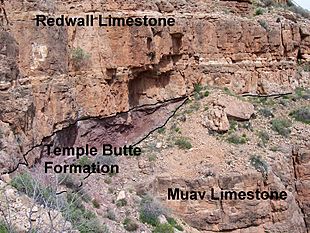Temple Butte Formation facts for kids
Quick facts for kids Temple Butte FormationStratigraphic range: Middle to Late Devonian 409–363Ma |
|
|---|---|
 |
|
| Type | Geological formation |
| Underlies | Redwall Limestone |
| Overlies | Muav Limestone- (unit 3 of the Tonto Group) |
| Thickness | 100 feet (30 m), at maximum |
| Lithology | |
| Primary | dolomite |
| Other | sandstone, mudstone, and limestone |
| Location | |
| Region | Northern Arizona (Grand Canyon) and (central) Arizona Nevada (southern) |
| Country | United States |
| Type section | |
| Named for | Temple Butte, Coconino County, Arizona. |
| Named by | Walcott (1889) |
The Temple Butte Formation is a special layer of rock found mostly in the Grand Canyon in Arizona, USA. You can also find it in parts of southeast Nevada. This rock layer formed during the Devonian Period, a very long time ago.
In the eastern Grand Canyon, the Temple Butte Formation appears as thin, broken patches. These patches fill old valleys that were carved into the rock layer below it, called the Muav Limestone. These patches are usually not very thick, reaching about 100 feet (30 m) at their deepest. However, in the central and western parts of the Grand Canyon, this rock layer is more continuous. It often blends in with the much thicker rock layer above it, the Redwall Limestone.
In the western and central Grand Canyon, the Temple Butte Formation gets thicker as you go west. It's made of different types of rock mixed together, like dolomite, sandy dolomite, sandstone, mudstone, and limestone. These rocks can be purple, reddish-purple, dark gray, or light gray. In the eastern Grand Canyon, the Temple Butte Formation fills shallow, ancient valleys. These valleys were carved into the Tonto Group of rocks, specifically the upper part of the Muav Limestone. The rocks filling these valleys are a mix of mudstone, sandstone, dolomite, and conglomerate. They are often purple, reddish-purple, or light gray. Usually, the rock filling these old valleys is a distinct pale, reddish-purple dolomite or sandy dolomite. These ancient valleys can be anywhere from 40 feet (12 m) to 100 feet (30 m) deep.
Contents
How the Temple Butte Formation Connects to Other Rocks
The top and bottom of the Temple Butte Formation are special boundaries called unconformities. This means there's a big gap in the rock record, showing that a lot of time passed, and some rock layers are missing. The bottom boundary, especially in the Grand Canyon, marks a huge time gap in the Paleozoic Era. This gap covers about 100 million years! It includes parts of the Late Cambrian period, all of the Ordovician and Silurian periods, and most of the Early and Middle Devonian periods.
The top boundary is also an unconformity, but it's usually flatter. Sometimes, you might find a layer of conglomerate (a rock made of pebbles and larger pieces) right above it, at the bottom of the Redwall Limestone.
Temple Butte Formation at Frenchman Mountain
At a place called Frenchman Mountain in Nevada, the rock layers between the Muav Limestone and the Redwall Limestone are much thicker. Here, there are over 2,000 feet (610 m) of limestone and dolomite. This is very different from the Grand Canyon, where the Temple Butte Formation is less than 100 feet (30 m) thick. The thicker rocks at Frenchman Mountain show that sediments were building up there during the same long time gaps that created the unconformities in the Grand Canyon.
Fossils Found in Temple Butte Rocks
Even though other rocks from the same time period in central Arizona have lots of invertebrate (animals without backbones) and vertebrate (animals with backbones) fossils, the Temple Butte Formation in the Grand Canyon doesn't have many easy-to-find fossils.
However, some fossils have been found:
- Some brachiopods (shellfish), gastropods (snails), and corals have been found in the lower part of Kanab Canyon.
- Fish plates from a type of armored fish called Bothriolepis were found in Sapphire Canyon.
- Possible trace fossils (marks left by ancient life, like burrows) have been seen in dolomite rocks near the bottom of the Temple Butte Formation in certain areas.
- Tiny fossils called conodonts, which are like teeth from an ancient eel-like creature, have been found in Matkatamiba Canyon. These conodonts help scientists figure out the age of the rocks.
Outside the Grand Canyon, in areas where the Temple Butte Formation is also known as the Sultan Limestone, more fossils have been found.
- In Mohave County, Arizona, and the Lake Mead National Recreation Area, scientists have found rare silicified (turned to stone by silica) corals, crinoid plates (from sea lilies), gastropods, and large stromatoporoid colonies (sponge-like creatures).
- The upper part of the Temple Butte Formation in Iceberg Ridge has conodonts from a later part of the Devonian Period.
- Further north in Nevada, on South Virgin Peak Ridge, fish plates from Holonema, Asterolepis, and sarcopterygians (lobe-finned fish) have been found. These fossils tell us the rocks are from the middle Devonian age.
Books About the Grand Canyon's Geology
If you want to learn more about the geology of the Grand Canyon and the rocks like the Temple Butte Formation, check out these books:
- Blakey, R, and W Ranney (2008) Ancient Landscapes of the Colorado Plateau. Grand Canyon Association, Grand Canyon Village, Arizona. 176 pp. ISBN: 978-1934656037
- Chronic, H (1983) Roadside Geology of Arizona. 23rd printing, Mountain Press Publishing Company, Missoula, Montana. 332 pp. ISBN: 978-0-87842-147-3
- Lucchitta, I (2001) Hiking Arizona's Geology. Mountaineers's Books, Seattle Washington. 290 pp. ISBN: 0-89886-730-4

